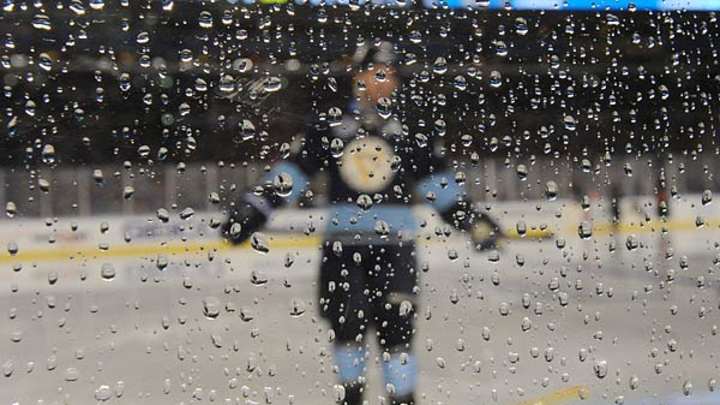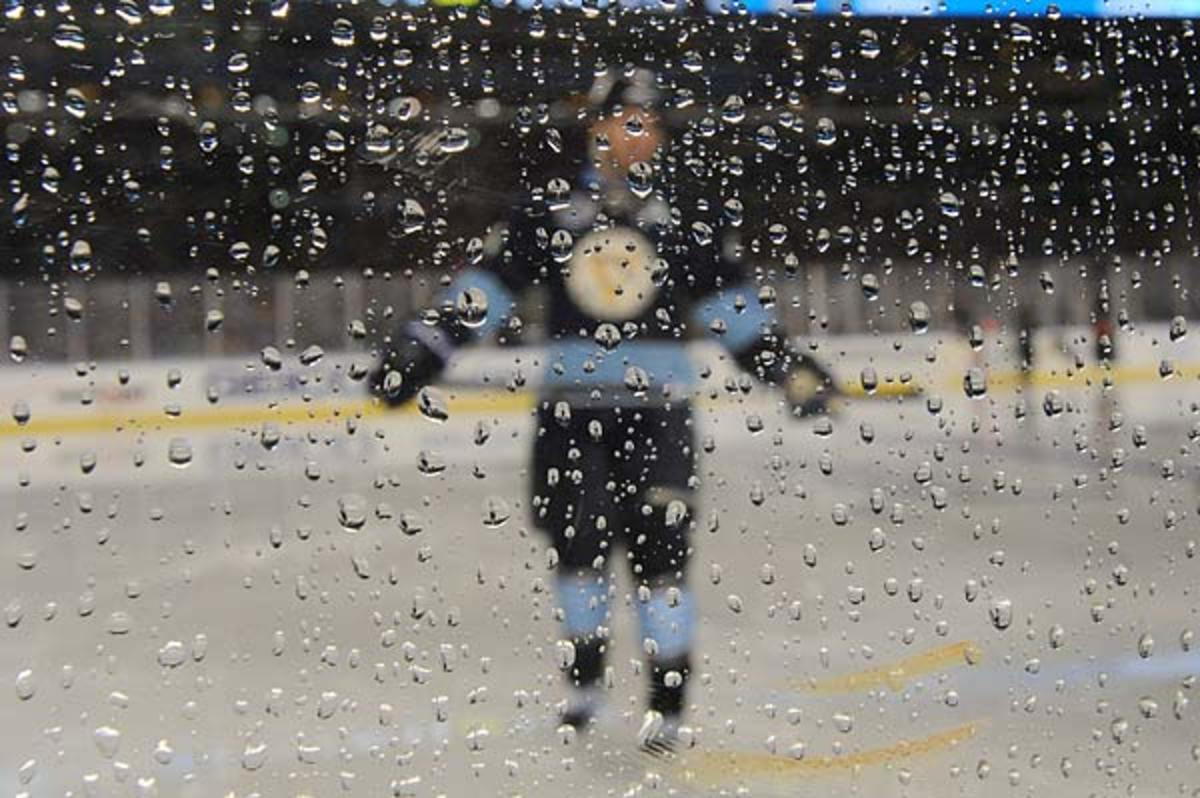Forecast for Winter Classic's future: uncertain

The weather was bad, but the TV ratings were good for the 2011 Winter Classic, yet next year's game will also be problematic. (Washington Post via Getty Images)

By Stu Hackel
What's the takeaway from the Winter Classic (apart from the dizzying, over-produced NBC telecast)?
As a spectacle, the rainswept scene on the banks of the Ohio River fell far short of the idyllic snowglobe fantasy of four years earlier on another football field in a suburban stadium southeast of Buffalo. As a hockey game, the Capitals-Penguins match was more informative than entertaining. As a TV show and business indicator, the NHL is happy, although it could have been happier.
And all these caveats have one source: the weather.
First, credit the NHL with pulling off this massive undertaking (not without some excesses) and braving the elements to create a special game that continues to grow despite unavoidable risks. And this year, the risks showed up.
The warm temperatures robbed the scene of its romance. Imagine that precipitation in 30-degree weather. Instead, we saw deteriorated ice that caused Alex Ovechkin's skate to give way has he shot late in the first period. It was only the first of a few tumbles taken by players and officials. The ice improved as the game went on, but was far from optimal.
"The rink had the eerie look of a northern lake the afternoon before the ice goes out in spring," as Roy MacGregor of The Globe and Mail wrote in his excellent account of the evening. "All that was lacking were the ghosts of snowmobile trails."
(We did get visible water trails following the puck, however, an ironic reminder of the FOX Glow-Puck, the most distracting artificial enhancement ever foisted on fans.)
The puddled ice transformed the game from what promised to be a thrilling matchup led by super-skilled talents into a grinders' contest. During the soggy third period, NBC's and Sports Illustrated's Pierre McGuire assessed the conditions and remarked that the great NFL coach Chuck Noll would have advised his Steelers teams to "Play through it," and McGuire's colleague Ed Olczyk deepened the metaphor by saying, "Run the ball."
And that's what the teams had to do.
The bouncing puck forced the players to abandon the fancy stuff, so the Sid vs. Ovie Show that the NHL and HBO had craved and pumped up never materialized. But in the process, other players revealed their uncanny abilities to play effectively on an awful surface. If you've ever played hockey on a wet sheet of ice, you know it can ruin the game. Rushes through the neutral zone and intricate passing become risky, so things reverted to pre-lockout style with lots of play along the boards, chipping it in and chipping it out.
That this game wasn't ruined and still looked like a credible NHL contest is a tribute to the players who don't get the attention that Crosby and Ovechkin do. And the players also deserve praise for enduring the conditions like the classy pros they are, with enthusiasm for the entire experience.
That the Caps came away with the 3-1 victory also says something important about them. The reputation of Bruce Boudreau's club in the past few years hasn't included concepts like "defensively sound" and "ability to make adjustments," and that has hurt them at important moments. But having recently come through a long losing streak, perhaps some changes have occurred. The Caps were more successful at the chip-and-chase, crash-the-net game than the Pens.
The Capitals even seem to have come up with a viable shutdown defensive tandem in rookies Karl Alzner and John Carlson, who have been learning their roles for a few games now and stopped Sidney Crosby on Saturday night. They'll have to keep it up on good ice going forward.
In the end, the play of Semyon Varlamov in goal typified a Caps team that is finally showing it can triumph over adversity. This game might be a defining moment for them.
How much of a defining moment this game is for the NHL from an image and business perspective is an open question.
For one thing, the Winter Classic is not currently a unifying event. On the contrary, while American hockey fans lovingly embrace the game as a validation of their hard devotion to a sport that rarely gets this sort of exposure in this country besides on Jan. 1, the response in Canada is cooler.
Canadian teams have been excluded from the Winter Classic because it is a TV-driven matchup, designed to maximize the U.S. ratings by featuring teams from two American markets. That distance forces Canadians to view the whole thing with some dispassion, which can be good when measured, like MacGregor's account of the game. But it can also be dismissive, like Don Cherry...
...or snarky, like Rob Longley in The Toronto Sun who wrote, "Bouncing pucks over sluggish, sloppy ice made for a game barely a grade above pond hockey for most of a soggy Saturday night in the Steel City...This was always more about hype than hockey anyway....Was it worth it? With the Super Bowl-hype it brought to the game, the league clearly thinks so, even if gala was upstaged by gimmick."
Some of the antipathy is born of jealousy, at least in Toronto where one writer says Pittsburgh "stole Toronto's sports dream." No doubt they'd love to host an outdoor game in Toronto and feel as if the game that their country invented deserves this kind of attention and treatment in that city -- the self-proclaimed centre of the hockey universe -- from the NHL.
But the Winter Classic shouldn't be a source of antagonism between U.S. and Canadian fans (let's keep that on the ice, in the World Junior Championship rivalry between the two countries). That's not a healthy situation for an international league. The league bears some responsibility for that. The Heritage Classic, the first NHL outdoor game, finally returns next month, seven years after its debut and it will get but a fraction of the attention from the NHL that the Winter Classic does.
And it doesn't help matters when some observers make wrongheaded appeals to dump the Canadian outdoor game entirely because it siphons off interest from the one in the U.S. Fortunately, the league doesn't feel that way, but it should not treat Canada as an afterthought, either.
One solution proposed by Jeff Z. Klein, blogging for The New York Times, and Margaret DeJesus of Pro Sports Blogging, is a Rangers-Maple Leafs Winter Classic (hey, Eggo's can sponsor it!). Klein wants it in Toronto, DeJesus wants it in New York.
That's not likely to happen. The TV-driven nature of the Winter Classic will likely increase after the NHL negotiates its next television contracts in the coming weeks. As Larry Brooks pointed out in The New York Post, "All those devoted hockey fans out there who have been clamoring for the NHL to strengthen its television presence should understand this without confusion -- the greater the rights fees, the greater control a network assumes over a league."
No, if anything, the NHL will plot to build on its best-ever TV rating from Saturday's game (4.5 million viewers, up 22 percent from last year's 3.7 million, earning a 2.3 national rating and 4 share in prime time, up 10 percent vs. last year's 2.1/4, in the afternoon). It may not be easy.
There almost certainly would have been bigger numbers had the game gone off in the afternoon this year. All the promotion was geared to a 1 PM start. Plus, the hockey audience was a bit dispersed with the local teams playing that night in important NHL TV markets like Boston, Buffalo and New York.
There have already been suggestions that the NHL move this game to prime time and make it the only NHL match that day. But the league will likely want to avoid the sort of prime time competition that it had this year. The ESPN telecast of the Fiesta Bowl got a 6.7 overnight rating, about three times the Pens-Caps rating, another factor that could have made this year's Winter Classic rating stronger had it not rained. There's less competition in the early afternoon.
As for clearing the schedule for Jan. 1, New Year's Day is a prime date for other NHL teams to fill their buildings. Unless the financial inducement from the Winter Classic is so great (it isn't at this time), it's not realistic to think owners will sacrifice their full houses for the sake of one event.
Plus, Jan. 1 falls on a Sunday next year. Assuming it doesn't opt for a shift to Dec. 31, the NHL is going to be up against the NFL no matter what time the game starts. How the league contends with that obstacle to improving on its ratings remains to be seen.
And it should not be forgotten that the rating benefited immeasurably from the HBO "24/7" series to help promote this year's game. It probably won't have that sort of boost next year.
Finding the next venue could likewise entail some difficulties. Baseball stadiums have poor sightlines, football stadiums require a team willing to surrender its home field for the last two weeks of the season. The NHL was extremely fortunate to have cooperation from the Steelers' owners, the Rooney family, and John Collins, the former NFL exec who is now the league's chief operating officer was justifiably appreciative, telling NHL.com "To be here at Heinz Field, the soul of Pittsburgh, where friends and family celebrate and unite, for the Rooneys to make room for us, it's just phenomenal. The Steelers are a first-class organization that expects to be in the playoffs every year. So for them to give up their last two regular-season home dates to make room for the NHL, it's almost too much to hope for."
It may be too much to hope for next year.
